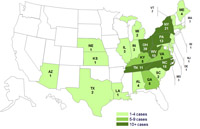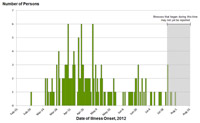Multistate Outbreak of Human Salmonella Infections Linked to Live Poultry
Posted August 20, 2012 3:45 PM ET
More Information:
Latest Case Count Map
Latest Epi Curve
Highlights
- Read the Advice to Consumers »
- A total of 163 persons infected with the outbreak strains of Salmonella Infantis, Salmonella Newport, and Salmonella Lille have been reported from 26 states.
- The number of ill persons identified in each state is as follows: Alabama (4), Arizona (1), Delaware (1), Georgia (5), Illinois (3), Indiana (3), Kansas (1), Kentucky (5), Louisiana (1), Maine (4), Maryland (3), Massachusetts (3), Michigan (2), Nebraska (1), New Jersey (1), New York (21), North Carolina (15), Ohio (39), Pennsylvania (13), Rhode Island (1), South Carolina (2), Tennessee (11), Texas (2), Vermont (2), Virginia (9), and West Virginia (10).
- 33% of ill persons have been hospitalized. Two deaths have been reported, one in New York and one in Maryland, but it is unclear whether Salmonella infection contributed to either of these deaths.
- 34% of ill persons are children 10 years of age or younger.
- Epidemiologic, laboratory, and traceback findings have linked this outbreak of human Salmonella infections to exposure to chicks and ducklings from Mt. Healthy Hatchery in Ohio. This is the same mail-order hatchery that was associated with the 2011 outbreak of Salmonella Altona and Salmonella Johannesburg infections. In May 2012, veterinarians from the Ohio Department of Agriculture inspected the mail-order hatchery and made recommendations for improvement.
- Mail-order hatcheries, agricultural feed stores, and others that sell or display chicks, ducklings, and other live poultry should provide health-related information [PDF - 1 page] to owners and potential purchasers of these birds prior to the point of purchase. This should include information about the risk of acquiring a Salmonella infection from contact with live poultry.
August 20, 2012
Case Count Update
A total of 163 persons infected with the outbreak strains of Salmonella Infantis, Salmonella Newport, and Salmonella Lille have been reported from 26 states. The 20 new cases are from 10 states: Illinois (2), Massachusetts (1), Maryland (2), New York (5), North Carolina (1), Ohio (2), Pennsylvania (2), South Carolina (1), Vermont (1), and West Virginia (3).
Among the persons who reported the date they became ill, illnesses began between March 1, 2012 and July 31, 2012. Infected individuals range in age from less than one year to 100 years, and 34% of ill persons are 10 years of age or younger. Fifty-three percent of ill persons are female. Among 100 ill persons with available information, 33 (33%) have been hospitalized. Two deaths have been reported, one in New York and one in Maryland, but it is unclear whether Salmonella infection contributed to either of these deaths.
During interviews, ill persons answered questions about contact with animals and foods consumed during the week before becoming ill. Seventy-five (81%) of 93 ill persons interviewed reported contact with live chicks and ducklings before becoming ill. Forty-eight (89%) of 54 ill persons with available purchase information reported buying chicks and ducklings that were sourced from a single mail-order hatchery in Ohio, Mt. Healthy Hatchery. Ill persons reported purchasing live poultry for backyard flocks to produce eggs or meat, or to keep as pets.
Illnesses that occurred after July 23, 2012 might not yet be reported due to the time it takes between when a person becomes ill and when the illness is reported.
July 12, 2012
Case Count Update
A total of 144 persons infected with the outbreak strains of Salmonella Infantis, Salmonella Newport, and Salmonella Lille have been reported from 26 states. The 21 new cases are from nine states: Arizona (1), Maine (1), Massachusetts (1), Michigan (1), North Carolina (2), Ohio (7), Pennsylvania (1), Tennessee (3), and Virginia (4).
Among the persons who reported the date they became ill, illnesses began between March 1, 2012 and June 22, 2012. Infected individuals range in age from less than one year to 100 years, and 36% of ill persons are 10 years of age or younger. Fifty-five percent of ill persons are female. Among 90 ill persons with available information, 32 (36%) have been hospitalized. One death has been reported in New York, but it is unclear whether infection contributed to the death.
During interviews, ill persons answered questions about contact with animals and foods consumed during the week before becoming ill. Seventy (85%) of 82 ill persons interviewed reported contact with live chicks and ducklings before becoming ill. Fifty-three (100%) of 53 ill persons with available purchase information reported buying chicks and ducklings that were sourced from a single mail-order hatchery in Ohio, Mt. Healthy Hatchery. Ill persons reported purchasing live poultry for backyard flocks to produce eggs or meat, or to keep as pets.
Illnesses that occurred after June 17, 2012 might not yet be reported due to the time it takes between when a person becomes ill and when the illness is reported.
June 7, 2012
Case Count Update
A total of 123 persons infected with outbreak strains of Salmonella Infantis, Salmonella Newport, and Salmonella Lille have been reported from 25 states. The 30 new cases are from 14 states: Alabama (1), Delaware (1), Georgia (2), Indiana (1), Kansas (1), Kentucky (1), Maine (1), New York (3), North Carolina (3), Ohio (4), Pennsylvania (1), Tennessee (4), Texas (1), and West Virginia (6).
Among the persons who reported the date they became ill, illnesses began between March 1, 2012 and May 22, 2012. Infected individuals range in age from less than one year to 100 years, and 36% of ill persons are 10 years of age or younger. Fifty-two percent of ill persons are female. Among 68 ill persons with available information, 26 (38%) have been hospitalized. One death has been reported in New York, but it is unclear whether infection contributed to the death.
During interviews, ill persons answered questions about contact with animals and foods consumed during the week before becoming ill. Fifty-seven (86%) of 66 ill persons interviewed reported contact with live chicks and ducklings before becoming ill. Forty-two (100%) of 42 ill persons with available purchase information reported buying chicks and ducklings that were sourced from a single mail-order hatchery in Ohio, Mt. Healthy Hatchery. Ill persons reported purchasing live poultry for backyard flocks to produce eggs or meat, or to keep as pets.
Illnesses that occurred after May 14, 2012 might not yet be reported due to the time it takes between when a person becomes ill and when the illness is reported.
Initial Announcement
May 30, 2012
CDC is collaborating with public health and agriculture officials in many states and the U.S. Department of Agriculture's (USDA), Animal and Plant Health Inspection Service, National Poultry Improvement Plan (NPIP) and Veterinary Services to investigate an outbreak of human Salmonella infections linked to chicks and ducklings from a single mail-order hatchery in Ohio. Public health investigators are using the PulseNet system to identify cases of illness that may be part of these outbreaks. In PulseNet, the national subtyping network of public health and food regulatory agency laboratories coordinated by CDC, DNA "fingerprints" of Salmonella bacteria are obtained through diagnostic testing with pulsed-field gel electrophoresis, or PFGE, to identify cases of illness that may be part of this outbreak... (show more »)
These outbreaks can be visually described with a chart showing the number of persons who became ill each day. This chart is called an epidemic curve or epi curve. Illnesses that occurred after May 6, 2012 might not yet be reported due to the time it takes between when a person becomes ill and when the illness is reported. This takes an average of 2 to 3 weeks. Please see the Salmonella Outbreak Investigations: Timeline for Reporting Cases for more details.
Contact with live poultry can be a source of human Salmonella infections. You should always wash hands thoroughly with soap and water right after touching live poultry or anything in the area where they live and roam. Adults should supervise hand washing for young children. Additional recommendations are available.
Mail-order hatcheries, agricultural feed stores, and others who sell or display chicks, ducklings and other live poultry should provide health-related information to owners and potential purchasers of these birds prior to the point of purchase. This should include information about the risk of acquiring a Salmonella infection from contact with live poultry.
Investigation of the Outbreak
As of May 25, 2012, a total of 93 persons infected with outbreak strains of Salmonella Infantis, Salmonella Newport, and Salmonella Lille have been reported from 23 states. The number of ill persons identified in each state is as follows: Alabama (3), Georgia (3), Illinois (1), Indiana (2), Kentucky (4), Louisiana (1), Massachusetts (1), Maryland (1), Maine (2), Michigan (1), Nebraska (1), New Jersey (1), North Carolina (9), New York (13), Ohio (26), Pennsylvania (9), Rhode Island (1), South Carolina (1), Tennessee (4), Texas (1), Virginia (6), Vermont (1), and West Virginia (1).
Among the persons who reported the date they became ill, illnesses began between March 1, 2012 and May 19, 2012. Infected individuals range in age from less than one year old to 100 years old, and 37% of ill persons are 10 years of age or younger. Fifty-one percent of ill persons are female. Among 36 ill persons with available information, 18 (50%) have been hospitalized. One death possibly related to this outbreak is under investigation.
In interviews, ill persons answered questions about contact with animals and foods consumed during the week before becoming ill. Thirty-seven (90%) of 41 ill persons interviewed reported contact with live chicks and ducklings before becoming ill. Thirty-two (100%) of 32 ill persons with available vendor information reported purchasing chicks and ducklings. Ill persons reported purchasing live poultry for backyard flocks to produce eggs or meat, or to keep as pets.
State health departments have tested chick and duckling samples collected from ill persons' homes. Four chick and duckling samples from different homes in Ohio and New York yielded the outbreak strains of Salmonella Infantis, Salmonella Newport, and Salmonella Lille.
Findings of multiple traceback investigations of live chicks and ducklings from homes of ill persons have identified a single mail-order hatchery in Ohio as the source of these chicks and ducklings. This is the same mail-order hatchery that was associated with the 2011 outbreak of Salmonella Altona and Salmonella Johannesburg infections. In May 2012, veterinarians from the Ohio Department of Agriculture inspected the mail-order hatchery and made recommendations for improvement.(« show less)
Get email updates
To receive email updates about this page, enter your email address:
Contact Us:
- Centers for Disease Control and Prevention
1600 Clifton Rd
Atlanta, GA 30333 - 800-CDC-INFO
(800-232-4636)
TTY: (888) 232-6348 - New Hours of Operation
8am-8pm ET/Monday-Friday
Closed Holidays - cdcinfo@cdc.gov




